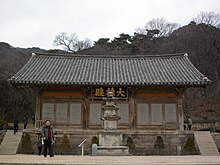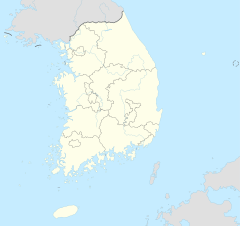Sudeoksa
| Sudeoksa | |
|---|---|
| Geography | |
| Coordinates | 36°39′48″N 126°37′20″E / 36.6633°N 126.6223°ECoordinates: 36°39′48″N 126°37′20″E / 36.6633°N 126.6223°E |
| Country | South Korea |
| Location | 79 Sudeoksa-angil Deoksan-myeon Yesan-gun South Chungcheong Province (Korean: 충청남도 예산군 덕산면 수덕사안길 79) |
| Elevation | 151 m (495 ft) |
| Sudeoksa | |

Sudeoksa Temple
|
|
| Korean name | |
|---|---|
| Hangul | 수덕사 |
| Hanja | 修德寺 |
| Revised Romanization | Sudeoksa |
| McCune–Reischauer | Sudŏksa |
Sudeoksa is a head temple of the Jogye Order of Korean Buddhism. It is located on the southern slopes of Deoksungsan in Deoksan-myeon, Yesan County, South Chungcheong Province, South Korea.
Sudeoksa was one of very few temples not destroyed during the Japanese invasions of Korea (1592–98) (the Imjin Wars). Its main hall is South Korea's oldest wooden building, having been constructed by Goryeo in 1308. This Mahavira Hall (hanja: ) is National Treasures of South Korea 49.
The Only Remaining Baekje Temple
Sudeoksa Temple (Korean: 수덕사, Chinese: 修德寺, Pronounced “Su-deok-sa”) has little known history as surviving records are scarce in comparison to its age. One record says it was established by Ven. Jimyeong Beopsa during the reign of Baekje’s King Wideok, and another tells that it was by Ven. Sungje Beopsa in the late Baekje era. Neither claim is backed up by records. However there is evidence that Ven. Hyehyeon taught at Sudeoksa in 601, and so the temple seems to have been established before that. There are 12 Baekje temples mentioned in literature, including Heungnyunsa, Wangheungsa, Chiraksa, Sudeoksa, Sajasa, and Mireuksa; Sudeoksa Temple is the only surviving one. Considering the fact that a number of Baekje-era roof tiles have been found there, it seems most likely that the temple originated in the Baekje era.
No particular records of Sudeoksa Temple from the Goryeo era remain, but a "ridge beam scroll," discovered during repairs reveals that the Main Buddha Hall was established in 1308. Thus, the temple must have maintained its stature as a major Buddhist temple until the end of the Goryeo era. It is said to have been renovated by Seon Master Naong Hyegeun in the latter part of the 14th century and Joseon era records state that the Main Buddha Hall was renovated in 1528 during the reigns of King Yeongjo and King Sunjo.
Cradle of Seon Buddhism in Korea’s Modern Era
In the late Korean Empire, Seon Master Gyeongheo lived here and taught the Seon tradition. He revived the practice and lineage tradition of Seon Buddhism, which had been discontinued in the 1880s. While residing at Sudeoksa Temple and nearby temples like Cheonjangam, Buseoksa and Gaesimsa, Ven. Gyeongheo ordained and taught disciples such as Suwol, Hyewol, Mangong and Hanam. Ven. Suwol went to Manchuria, lived the life of a secluded sage, and entered paranirvana. Ven. Hyewol went to Busan and established a lineage that transmitted the Dharma to monks Unbong Seongsu, Hyanggok Hyerim and Jinje Beobwon.
...
Wikipedia

